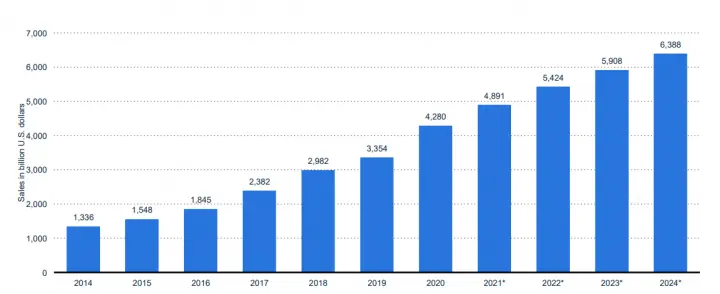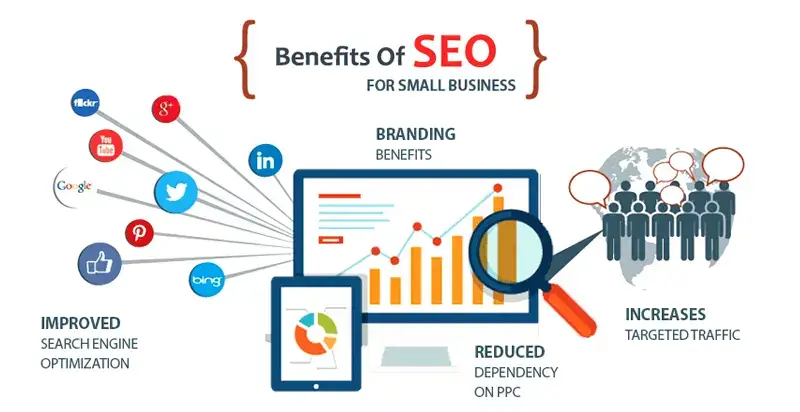E-commerce SEO can increase product sales, but how can you implement it on a new or existing website?
This guide aims to make it easy for someone who is new to eCommerce SEO to understand and start driving quality sales within a few months.
SEO in eCommerce has never been more important than it is in 2023. Statistics show that nearly half of all online shoppers start with a search query.
As Alex Quin, Chief Marketing Officer, UADV Marketing put it:
Sales in eCommerce show no signs of slowing. Use every resource to your advantage so you stay competitive. Let's dive in and find out more!

Source: Source
What is E-Commerce SEO?
eCommerce SEO refers to the practice of ranking products from an eCommerce website high on the search engine results page (SERPs) so that potential customers searching for those products can make purchases from the website.
This practice involves optimizing the eCommerce website for keywords (search terms) that prospective customers use to find and buy products.
Additionally, a people search tool helps customers find relevant information about individuals to secure product purchases.
Optimization includes enhancing product descriptions, headlines, metadata, navigational structure, interlink structure, user experience, and more.
Website owners or SEO experts undertake eCommerce SEO to drive quality traffic, leads, and sales to the website. Unlike running paid ads, eCommerce SEO provides long-term growth results.
Why Does an E-Commerce Site Need SEO?
Implementing Search Engine Optimization for an eCommerce website offers numerous benefits.
It brings your website to the attention of people genuinely interested in buying from you, boosting your revenue and enhancing your website's credibility.
Many potential customers search online for product reviews, comparisons, recommendations, tips, and other information to aid their buying decisions.
By optimizing your eCommerce website for SEO, you ensure it appears in relevant search results.
If you're looking for affordable SEO agency services, it's crucial to focus on strategies that will drive long-term results without overspending.

Source: Source
6 E-Commerce SEO Best Practices For Beginners
As a beginner, it's helpful to either learn or consult with a professional commerce SEO agency to apply best practices specific to eCommerce websites. This article will discuss each of these practices.
eCommerce SEO begins by addressing basic aspects such as navigation, internal linking, content creation, adding meta tags, and other technical SEO considerations. Here are the steps to start optimizing an eCommerce website:
1. Perform keyword research
Keyword research forms the foundation of a successful eCommerce website.
Finding the right keywords enables you to be easily discovered by potential customers. Optimizing your website for target keywords is crucial for achieving desired results.
There are two main categories of keywords that work well for eCommerce websites:
Commercial keywords
These are keywords that indicate an immediate intent to purchase.
Examples include "buy Bluetooth speakers," "laptop coupon codes," "new iPhone deals," and "best waist beads for a fat person."
Informational keywords
These are keywords people search for to learn about a particular subject or make informed buying decisions.
They often contain words like "what," "how to," and "facts."
SEO tools like Ubersuggest and Semrush can assist with keyword research. Semrush is a paid SEO tool, but you can use the free Semrush trial to see its effectiveness.
2. Optimize your product pages
This stage involves showcasing your On-Page SEO skills. By now, you should have identified your target keywords, as they are crucial for the optimization process.
Here are some tips for optimizing your product pages:
Product descriptions
Craft compelling, keyword-rich descriptions that appeal to humans and search engines.
Include unique images, incorporate target and related keywords, add an attractive call-to-action button, and include testimonials.
Images
Optimize the images on your product description pages to improve visibility on search engine image searches.
Compress images for faster site speed, use keywords in image alt tags and file names, and consider adding captions.
Customer reviews
Encourage customer reviews as they help potential buyers make decisions. You can send email autoresponders to follow up with customers after purchase.
Reviews enhance site engagement and, in turn, contribute to higher search engine rankings.

Source: Source
Ensure your product pages are well-written and include all necessary information. Include at least one call to action, provide shipping details and policies, and strive for a user-friendly design.
3. Consider the UX (User Experience)
The previously mentioned steps may be ineffective if your eCommerce website lacks a user-friendly experience.
Poor user experience can lead to decreased website engagement, increased bounce rates, reduced time spent on the site, lower conversion rates, and decreased traffic.
These factors can also negatively impact your search engine rankings. Improve website experience (UX) by following these tips:
- Avoid intrusive ads or pop-ups that hinder user interaction.
- Ensure your website loads quickly.
- Incorporate relevant calls-to-action when appropriate.
4. Use a simple URL structure
Simplifying your website's URL structure has several advantages.
Short, readable URLs are more likely to be trusted and clicked by users. The URL must also be legible and understandable so that sharing it on social media is easier.

Source: Source
Additionally, search engines will better understand your webpage's content. Consider the following tips for a better URL structure:
- Use keywords in the URL to clearly indicate the page's topic.
- Avoid using unnecessary words (stop words) such as "and," "of," and "a."
5. Increase your website page speed
Website page speed, directly and indirectly, affects SEO. If you notice that your competitors have better website speed, follow these steps to improve yours:
- Compress image sizes to enhance site speed while maintaining image quality.
- Compress other files.
- Reduce social widgets on web pages.
- Minimize redirects and HTTPS requests.
- Optimize your search response time.
- Choose a reliable web host.
If you use WordPress, consider using plugins like WP Rocket, W3 Total Cache, and Cache Enabler.
6. Publish text-based content
Don't overlook text-based content like blog posts—even for an eCommerce website.
SEO-optimized content on your eCommerce site attracts more potential customers, builds trust, and improves engagement, leading to increased sales.
Consider posting information-based content such as how-to guides, FAQ pages, news articles, product launches, virtual events, webinars, glossary pages, and more.
Conclusion
Implementing eCommerce SEO may require effort, but the results are rewarding. Follow this guide and put it into practice.
In addition to the eCommerce SEO tips discussed above, avoid duplicate pages, utilize Schema Markups, and build backlinks to enhance your SEO efforts further.
Feel free to share this article with others who may be interested in learning about eCommerce SEO.

Author Bio
Vibhu Dhariwal is the Co-Founder & Director of Marketing at Digital Gratified, a Digital Marketing & Web Development company.
He enjoys sharing his expertise in outreach marketing, link building, content marketing, and SEO with readers. Connect with him on LinkedIn to learn more about him.

